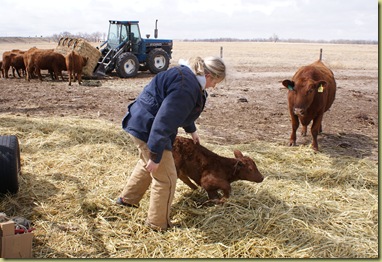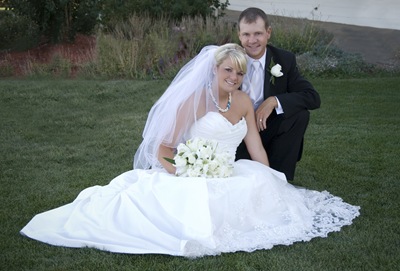a blog about family, ranching, quilting, agriculture and the volatility of life.
Thursday, October 22, 2009
CSI did NOT do the research...
Mutant CSI Script Rolls Out the Misinformation
By Mark Posted: October 21, 2009
Since when did CSI Miami become a science fiction offering? The only crime on last night’s episode titled “Bad Seed” was a poor script and even worse research. The last time I saw this much misinformation in one place it was a political convention.
Apparently the creative well of ideas on novel ways to send people to the great beyond must have dried up in season 8. With more versions of CSI than there are television networks, I guess this was bound to happen.
The convoluted plot line did no less than trying to link together E-coli, water pollution from a cattle feedlot, botulism and genetic engineering in corn into a single plot line that came off looking like a spoof of a bad ‘70’s cop show.
If you watched this episode as a blank slate you would walk away thinking farms today are big/corporate, cold and uncaring (hey, we don’t mind killing a few of you if it is for the greater good), technology is bad, and there is no oversight what so ever over food quality or how it is produced.
Rather than rehash all the implausible points in last night’s story line let’s just say there are four big reasons why this CSI train wreck would never happen: 1. The Food and Drug Administration 2. The Environmental Protection Agency 3. The U.S. Department of Agriculture 4. Family farmers who are the best in the world at what they do.
A couple of words of advice in closing: If you want to do a story on corn, try any place but Florida. They grow a whopping 160,000 acres of field corn all of which is fed to cattle, not people. Think CSI Des Moines!
Tuesday, October 20, 2009
Corn!!


Thursday, October 15, 2009
Blog Action Day – Agriculture on the Offense
Every October 15 is Blog Action Day where bloggers around the world post about the same issue on the same day with the aim of sparking discussion around an issue of global importance. This year’s topic is Climate Change.
I was just going to skip over this, as I have plenty of other things to do this morning, but then the little voice in my head said, “This is a chance to be on the offense with agriculture.”
Lately, agriculture has had to be on the defense with multiple facets of media outlets and activists attacking it whenever they’re given a little bit of room to grow on. Some of you probably know about the Time Magazine article that falsely reported on “factory farms” and corporate agriculture. This brought on a lot of heat to the world of agriculture and for some, tipped them over the edge to really start doing something to put agriculture on the offense and to prevent us from being on the defense.
As I start my job with the Nebraska Corn Board next week, here are some quick facts about corn and the environment:
1. Ethanol is made from corn: Cars made to run on ethanol would help alleviate our dependence on petroleum based fuels, would provide a boost to the corn growers industry, it’s a renewable resource, its biodegradable, and it burns cleaner than gas. (Environment Site)
2. Many know that fertilizer and chemical run-off from being applied improperly can enter into our water systems; however, genetically-modified crops, like Round-up Ready Corn, allows for less chemicals to be applied to the crop. In 2003, biotech crops improved farm income by $1.9 billion, increased crop yields by 5.3 billion pounds, reduced pesticide use by 46.4 million pounds and encouraged more conservation tillage. (National Center for Food and Agricultural Policy)
Amanda from the BEEF Daily blog, gave 10 great quick facts about Cattle and the Planet:
1. American agriculture is sustainable for the future. In the United States, 98 percent of farms are family farms. Today’s American farmer feeds about 144 people worldwide. 2009 versus 1960: 1.8 million less farms are feeding a U.S. population that has increased 61 percent. (Explore Beef)
2. According to the Environmental Protection Agency, the entire U.S. agriculture sector accounts for only 6 percent of annual U.S. greenhouse gas emissions. Of this, livestock production is estimated to account for 2.8 percent of total U.S. emissions. (EPA Climate Change Report)
3. If livestock production disappeared tomorrow, wouldn’t we just be transporting more tofu around? And wouldn’t we just be plowing and fertilizing the land to supply PETA’s vegetarian utopia? (Center for Consumer Freedom)
4. Grazing animals on land not suitable for producing crops more than doubles the land area that can be used to produce food. If 1955 technology were used to produce the amount of beef raised today, 165 million more acres of land would be needed – that’s about the size of Texas! (Explore Beef)
5. Each year, outstanding ranching families are recognized through a prestigious award, the Environmental Stewardship Award Program. The award is presented each year by the National Cattlemen’s Beef Association and The National Cattlemen’s Foundation, and is sponsored by Dow AgroSciences and USDA’s Natural Resources Conservation Service at the annual Cattle Industry Annual Convention. (Read about the regional winners at BEEF)
6. Cattle do more than just provide us with nutritious beef. They also make significant contributions to our lives… and the planet. Cattle convert inedible cellulose (grass) to nutritious beef. When cattle graze, they “aerate” the soil with their hooves, which allows more oxygen and water to enter. They also press grass seed into the soil, so it can start growing. They provide a natural fertilizer in the form of manure. Cattle also reduce the length of grass and brush when they graze, which is helpful in reducing the spread of wildfires since there is less flammable material. In addition, cattle primarily graze on grass, but they also eat waste products from food processing such as potato skins, distillers grains, fruit pits, almond hulls and sugar beet pulp. (Wow That Cow!)
7. Beef by-products enable us to use 99% of every beef animal, and these products are a part of our daily lives. Beef by-products include leather, candles, toothpaste, deodorants, crayons, textiles, cosmetics, rubber tires, insulin, high glass for magazines, asphalt, fertilizers, cement blocks, hydraulic brake fluid, car polishes and waxes, detergents, shaving cream, soaps, shampoo, paint, chewing gum, marshmallows, and the list goes on, and on, and on. Can you go a day without using a cattle by-product? (When is a Cow More Than a Cow?)
8. There are 29 cuts of beef that meet the government labeling guidelines for lean. Each one contains less than 10 grams of total fat, 4.5 grams or less of saturated fat, and less than 95 milligrams of cholesterol per 3.5 oz. serving. Calorie-for-calorie, beef is the most nutrient-dense food including nine essential nutrients, including a good source of zinc, iron and protein. And, did you know, beef has the same heart-healthy fats as olive oil? (Beef, It’s What’s For Dinner)
9. According to a 1993 article in the Journal of Animal Science by J. Beckett and J. Oltjen, total livestock production accounts for just over 11 percent of all U.S. water use in the United States. This includes the water to grow crops fed to livestock, which accounts for 9.7 percent of all water use, and livestock consumption, at 1.2 percent of all water use. (Journal of Animal Science)
10. Rangelands and pastures provide forage and habitat for numerous wildlife species, including 20 million deer, 500,000 pronghorn antelope, 400,000 elk and 55,000 feral horses and burros. Last year, more than 2,000 ranchers and farmers entered into landowner agreements with the Partners for Fish and Wildlife Program. About a billion acres, or 55 percent of the total land surface in the United States, is rangeland, pasture and forages. (Beef, From Pasture to Plate)
 So, fellow ag bloggers and those concerned about animal welfare, please post something today, register your blog, and help agriculture be on the offense of this fight!
So, fellow ag bloggers and those concerned about animal welfare, please post something today, register your blog, and help agriculture be on the offense of this fight!
Wednesday, October 7, 2009
finally…..
…an update from me! Did you think I dropped off the planet?? I feel like I have! ha ha! First, I’ve been sick for almost three weeks, and just trying to get energy to put away wedding gifts has been a chore, much less trying to finish my thesis defense project, clean, cook and take care of my busy husband.
For those out of the loop, Ronny and I got married on September 19! We then took a week-long honeymoon to Cabo San Lucas, Mexico (I will post an update with pictures of that soon!). We got back and Ronny had to get right back to work traveling, and I’ve been preparing for my thesis defense presentation, which I give tomorrow. I should be polishing it right now, but I also got a couple of wedding pictures today as a “tease” and I wanted to share them!
I love them all!!





